Deer feeders are commonly used by hunters, animal lovers, and wildlife enthusiasts. They can come in a variety of designs and sizes for different uses.
You also get digital timers with modern units so you can customize the time frame to feed these animals as you please, just the way you set alarms on your mobile phones.
Their noiseless motors and agitators facilitate a balanced and consistent distribution of food throughout the preset time frame.
How Do Deer Feeders Work?
1. Automatic deer feeders
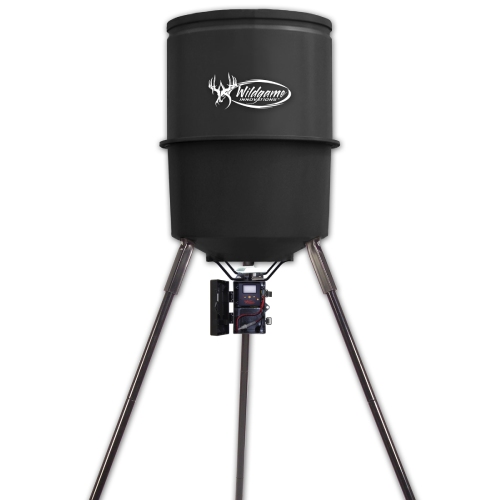
An automatic feeder can help ensure your success in the coming deer season because you can take the game exactly to the place you want them to be as the hunting season approaches.
Or, you can get a feeder as a pleasant addition to the backyard in case you want to invite these peaceful animals and watch them feed.
The advanced models don’t necessitate much manual intervention. You only need to add food and set the wire and the timer.
Solar panels are a great help as far as a power supply in the wild is concerned.
Everything else is digitally done with mobile apps or other remote-controlled devices.
Pro tip: Make sure to get a waterproof feeder to keep the feed from getting damp, molded, and spoiled.
A locking lid on your feeder will help you fend off bears, hogs, and squirrels. Durability will matter when the weather gets rough.
2. Gravity deer feeders

Gravity feeders operate on movements and don’t need a motor to dispense the feed.
They feature adjustable agitators and dispensers that keep the grain dispensing as the animals begin to feed.
The feeds are protected by the lock and a user-friendly lid that doesn’t easily slide off.
Some gravity feeders are elevated with only one center post, but others have come up with a more modern approach with three or four legs.
Note: The single-center post design allows the deer to easily access the feed without many obstacles coming their way, but the standard tripod feeders can hold up a really large container pack or barrel.
3. Road feeders with wireless remote controls
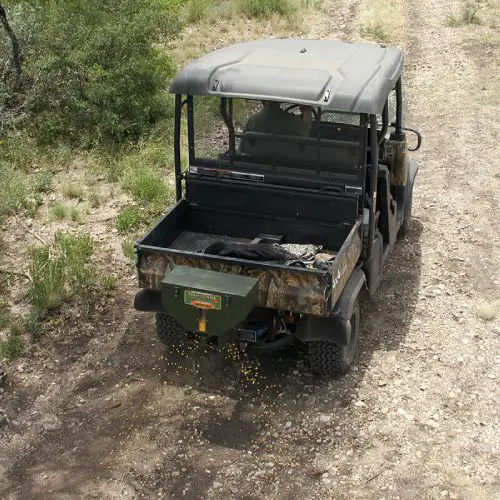
Long gone are the days when deer feeders were placed in one place and now you can even entice the bucks into your hunting ground using the road feeders.
They’re ideal for ATVs and designed to mount on the rearmost or anterior of almost any vehicle.
So, how do they work?
They come with a 2-inch receiver and support two power alternatives. You can either power with your vehicle or put in a customary 12-volt battery.
The road feeder will start dispensing the feed with a press of a button on the wireless remote.
Their key features include a 12-volt high torque motor, a rechargeable 12-volt battery, a lid-stops vehicle protector, a weather-protected hinged latch and lid, a heavy-duty trail deflector plate, and some additional components.
4. Capsule feeders
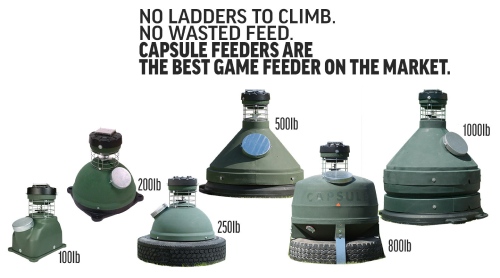
Capsule deer feeders are one of the most exciting things that come along to the feeder manufacturing industry in a long time.
The best thing about these feeders is that the corn will last about twice as long as in other standard feeders.
You can load up a 1000 lbs feeder at the beginning of the deer season and feed a couple of times a day and your corn will last for months.
The benefit of a capsule feeder is humongous because the coons, cows, hogs, and critters cannot shake your corn out like in other feeders.
The key advantage is that they sit on the ground and use gravity to auger the food up and out.
You literally no longer need to climb up a rickety ladder or carry heavy sacks on your shoulder.
You can simply take the corn bags right off the tailgate and landfill them straight into the side hole of the feeder.
You can get a capsule feeder for yourself for $40 to a little up to $1000 depending on the size and feature.
Capsule feeders use an American-made heavy motor. There is an auger set inside which is driven by the motor to throw off the corn up to 20 feet around.
Unused feed drops back into the feeder to prevent varmints and nosey bears.
10 Things to Know Before You Get a Deer Feeder
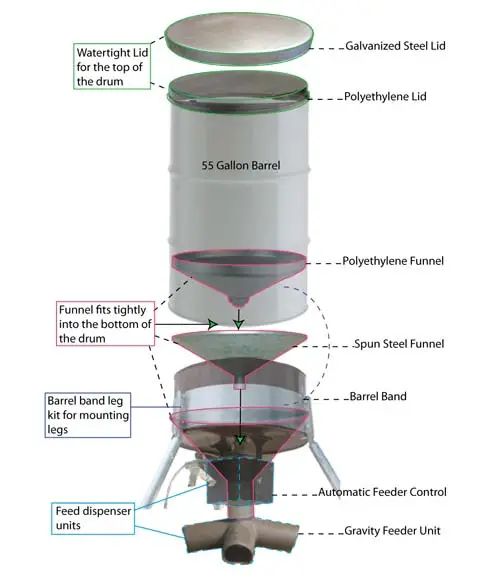
1. Container capacity
A few things should be considered thoroughly when it comes to feed storage capacity. G
o for smaller sizes if you like to hunt in random remote places and portability is your priority.
If you’re not a frequent visitor to your hunting ground but still want to maintain a routine to feed the bucks, you need a feeder with a big stock so you don’t have to refill it every so often.
2. Weight
If you’d like the feeder to stand in one place so the deers can build a habit of coming to you, a heavy feeder is fine.
You might need quite a bit of help on a regular basis with a heavy feeder since it will be hard to set up and operate in the first place.
Wisely select the type that suits your needs.
3. Triggering mechanism
In photocell feeders, a timer commands the motor’s run-time and a sensor keeps track of the light and time to follow up with the automatic feeding at dusk and dawn.
4. Varmint proofing
Do not forget the raccoons and squirrels as you set a feeder for the deer.
Both deer and raccoons love corn and you cannot fence the feeder for the varmints and let the bucks in at the same time.
Squirrels and raccoons have also been seen chewing through the wiring.
Keep in mind that a built-in varmint guard will definitely work way better than the so-called zip tie and chicken wire solution.
5. Standing vs hanging
You can set up the tripod or four-legged feeders in almost any place you please.
But if they’re not sturdy enough, wild beasts like bears and cattle can get in the way to damage them.
You may be able to keep the hanging feeders out of the reach for such destructive visitors but you always need a tree to hang them.
6. Shape
A flat-bottomed feeder can be frustrating because you need to shake them a few times to make sure the feed is efficiently dwindling onto the spinner.
But a funnel-shaped bottom will keep your corn moving in the correct direction just as you would expect.
7. Ease of filling
Don’t go for a feeder that’s too high that you can’t see the lid from above while standing on the back of your truck.
It should be just about the height that you don’t need to lift the feed bags above your head when you pour them in.
The good news is, you’ll find feeders that come with adjustable legs so you can customize the height accordingly.
8. Durability
When it comes to deer feeders; especially the ones that stand in the middle of nowhere out in the wild, they should be extremely strong.
Your deer feeder needs to be strong enough to pass the roughest of weather and to withstand the madness of a bunch of wild bears.
9. Deer feed
Use the right feed to get the big bucks. Deer corns are available in a large variety of options and flavors.
Some are apple-flavored and some are plain. Some say the added flavors scare the deer away but some are strongly against it.
Feel free to try different feeds to check on which one gets the most attention from your local bucks.
10. Hunter’s secret

It might be surprising to you that the deer has a taste for salt.
A block of salt lick will keep the deer in your feeder for a little longer. The flavored salt blocks will work even better.
Break the ground a bit and place it in the pack of granulated or powdered flavors and witness how the deer lick the place every time they pass by.
It’ll buy you some more time to get the gun forward.
FAQs
1. How effective are deer feeders?
Ans: They are effective in the areas that are most used to the feeders. If you’re the first to provide a feeder in your region, it might take you a few weeks or more to get the bucks in the backyard.
2. How long does it take deer to find a feeder?
Ans: It’ll mostly depend on the location and the nature of the deer but usually it might take the deer a week or so to find your feeder.
3. Why have deer stopped coming to my feeder?
Ans: Perhaps your feed got soggy or mushy. It could be a hunter who scared all the deer away, or they may have found another feeder somewhere near their homes.
4. Do deer feeders spook deer?
Ans: Yes! But once the deer will get used to it, it’ll be easier for you to have a clear look at them.
5. How do you get bucks to come to your feeder?
Ans: Dispense some corn to the roads that you want the deers to come to your feeder using a road feeder. Or put some flavored cattle salt blocks in places in the feeder’s way since the deer will find them enticing.
6. How long does it take deer to get used to electric feeders?
Ans: On average, it’ll take two to three weeks for a deer to get used to a modern electric feeder.

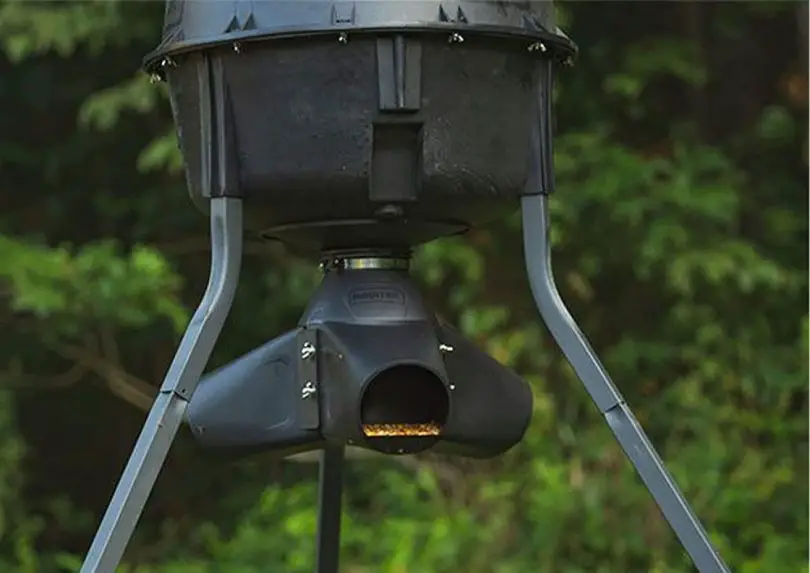







Leave a Comment